Just because you can fix a 35 year-old ham transceiver does it mean you should?
In this case, my answer was yes. The Kenwood TS-930S is famous for several kinds of annoying breakdowns, most especially in the power supply. The fans are controlled by a temperature-sensing circuit. The sensors drift with age, driving up how hot it must get to activate the fan on the power supply and on the power amplifier, both. Eventually, the fans will only come on at meltdown temperature. Predictably, things melt down and fail.
I ended up with this radio after the customer tried to fix it himself. Fried the circuit board that regulates the power supply and controls the fan on the power-supply heat sink. A search of the 'net turned up folks looking for this board, but nobody selling one that sounded trustworthy.
Fast-forward a few years. No I didn't s**t-can the radio in the meantime. A guy with the callsign K6IOK has a company called Compudigital. They sell a switchmode power supply that fits (barely) in place of the original 60-Hz power transformer, and a circuit board with swithmode regulators to step down the radio's internal regulated voltages.
http://www.k6iok.com
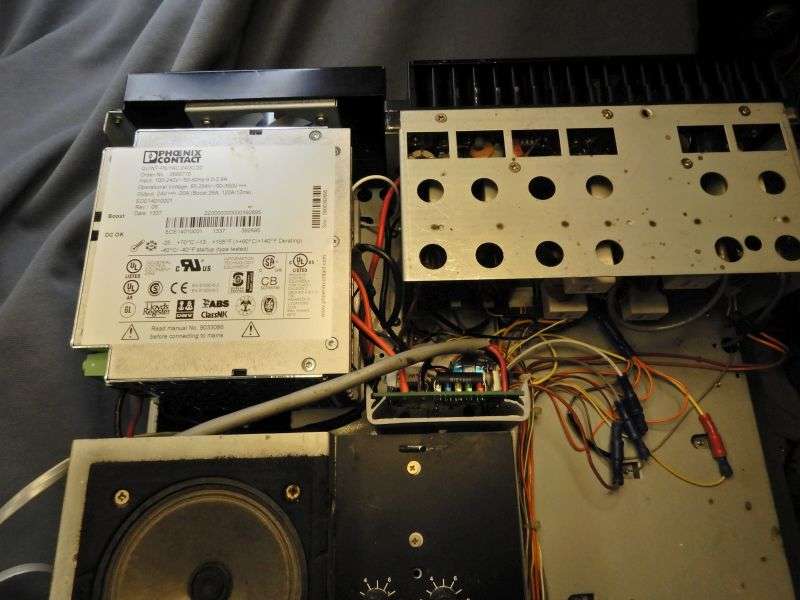
One thing that made the $260 for the upgrade kit seem worthwhile was the upgraded PIEXX cpu board this radio already had installed in it. This board provides a RS-232 data interface and improvements to the radio's memory features and tuning rate. Also needs no battery for memory backup. Every product I have seen from PIEXX has been everything they claim.
http://www.piexx.com
The owner-attempted repair had tripped what I call the TS-930's "auxiliary fuse". This is the solder side of a small pc board at the rear of the radio. Has a power relay mounted on the other side that handles the actual power switching to the original power transformer. The push button on the front of the radio only serves to power-on this relay.
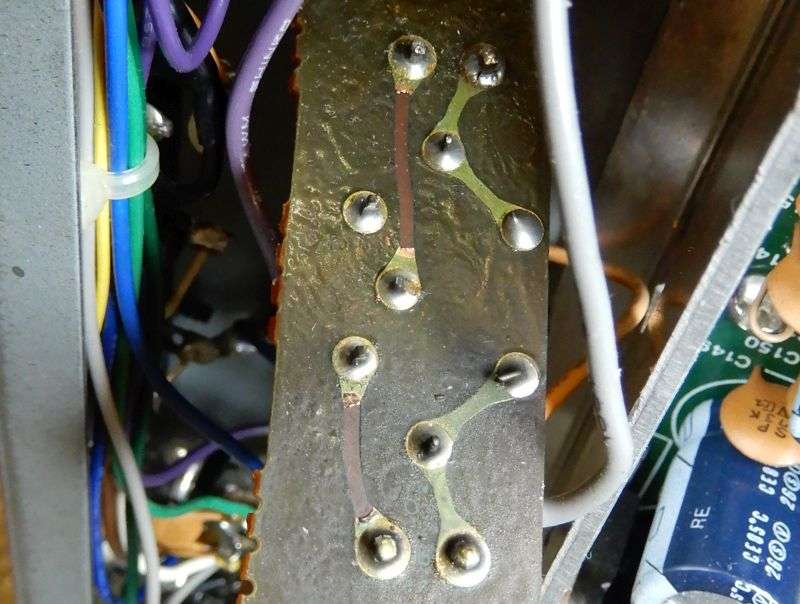
The fix for this fault is simple enough.
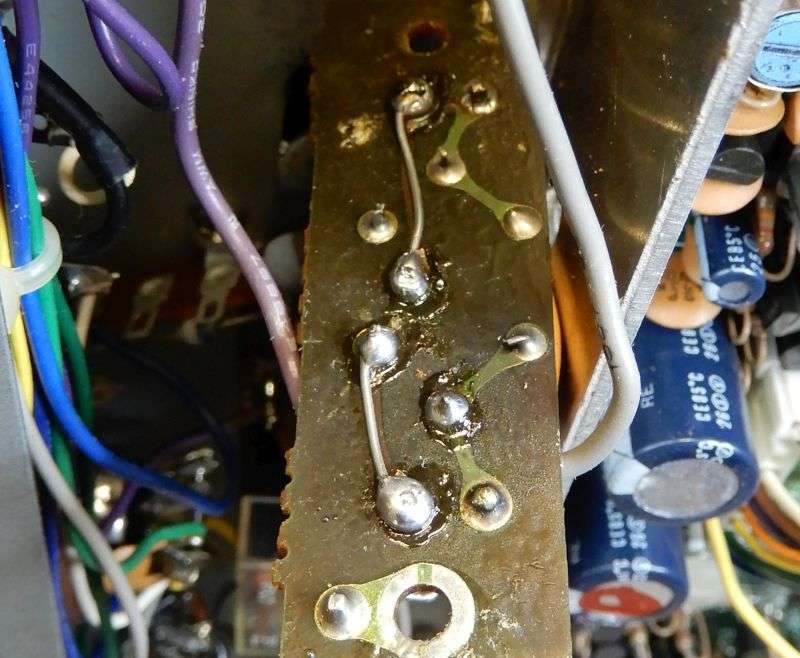
Fortunately the relay is stout enough to shrug off the stress from having to vaporize the two foil traces.
Does leave a visible scorch mark on the chassis where this board is mounted.
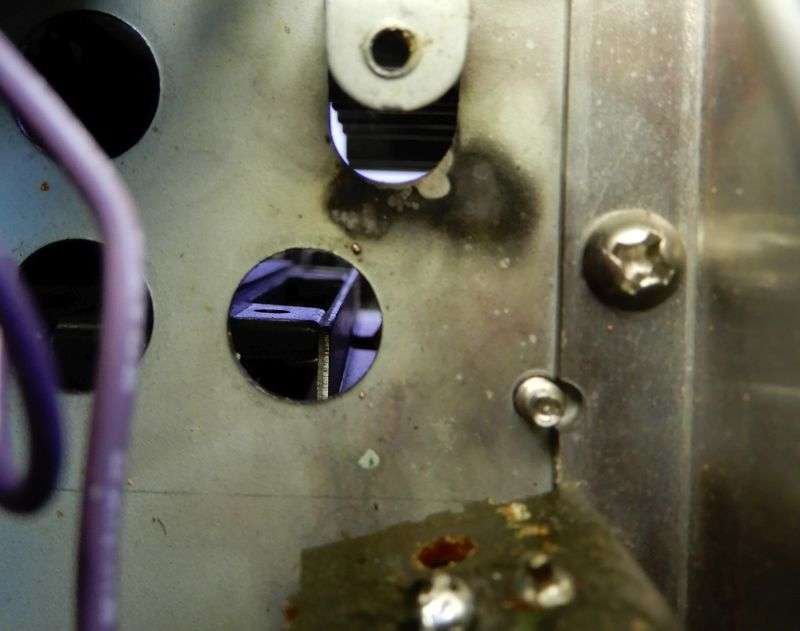
But you won't spot this "hint" until you unbolt the relay circuit board.
This pc board comes with the kit and contains the step-down regulators and power sockets to run both fans continuosly.
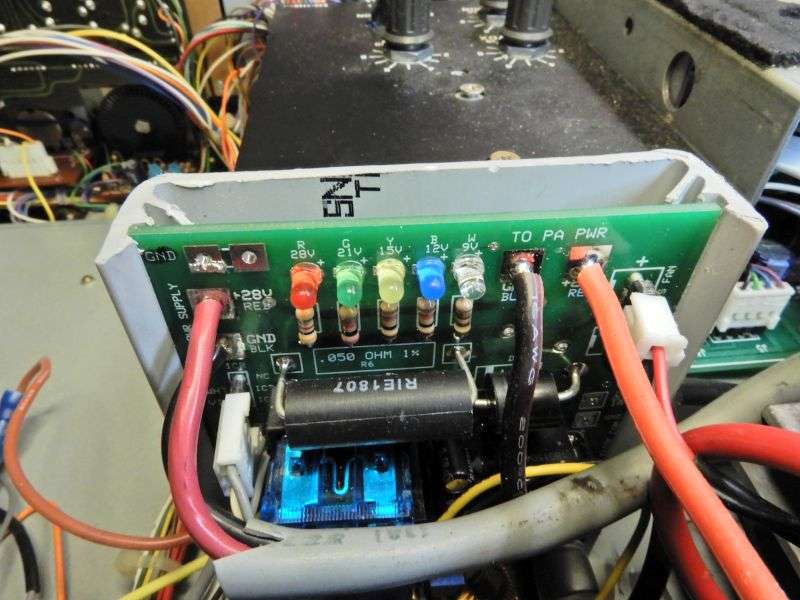
The hookup is not so tricky, but there are two basic versions of the TS-930S. The hookup is slightly different for each.
There are links to some other web pages for the TS-930S at the K6IOK web site that helped to sort out the early radio (this one) from the later version.
The row of LEDs at the top edge of the regulator board shows the status of each input and output. Didn't have to use this feature for troubleshooting, but it still looks cool.
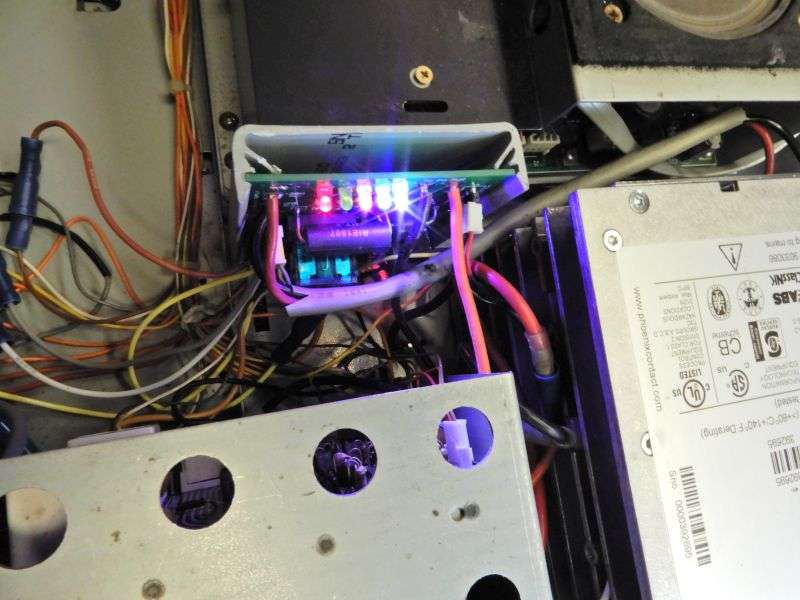
I chose not to run the power-amplifier fan full time. The thermal controller was in fact not working when I did a "hammer test" with a 100-Watt carrier. I decided a better compromise was to run the fan only while the transmitter is keyed. After some cutting and trying, the patch I settled on was a 100-ohm resistor across the two wires on the plug that leads from the low-pass filter board to the power-amplifier board where the temp-sensing thermistor is. Not a terribly neat hookup, since it wasn't the first thing I tried. Does the job.
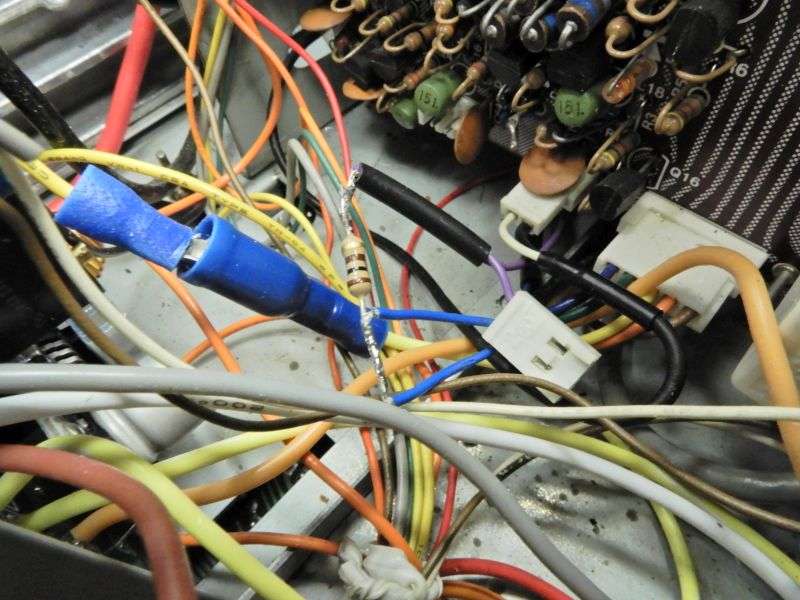
I skipped the one detail that probably caused the radio's owner to dive into it in the first place. The power-amplifier board has a single predriver transistor, followed by a push-pull pair of long-discontinued MRF-485 transistors, driving a pair of MRF-422 final transistors.
The predriver transistor was bad. It's a 2SC2075. It was sold as a final for 4-Watt CB radios. The other transistors are exotic 28-Volt parts, but this one seemed out of place. Turns out it has a high breakdown-voltage rating. Had one on hand, a holdover from fixing early-1980s CB radios. A new part got the radio to transmit again. \
Go figure. All it needed to begin with was probably that one dinky CB-final transistor.
And a way to make the fans run. Guess I'm lucky the cheap transistor was the first one to break down.
Now it's time to put the antenna tuner back in and see how long this thing will run.
I'm not sure a customer would consider the total price of this job to be "worth it", compared to the price of a newer radio. Was definitely worth it to me.
So far.
73
In this case, my answer was yes. The Kenwood TS-930S is famous for several kinds of annoying breakdowns, most especially in the power supply. The fans are controlled by a temperature-sensing circuit. The sensors drift with age, driving up how hot it must get to activate the fan on the power supply and on the power amplifier, both. Eventually, the fans will only come on at meltdown temperature. Predictably, things melt down and fail.
I ended up with this radio after the customer tried to fix it himself. Fried the circuit board that regulates the power supply and controls the fan on the power-supply heat sink. A search of the 'net turned up folks looking for this board, but nobody selling one that sounded trustworthy.
Fast-forward a few years. No I didn't s**t-can the radio in the meantime. A guy with the callsign K6IOK has a company called Compudigital. They sell a switchmode power supply that fits (barely) in place of the original 60-Hz power transformer, and a circuit board with swithmode regulators to step down the radio's internal regulated voltages.
http://www.k6iok.com

One thing that made the $260 for the upgrade kit seem worthwhile was the upgraded PIEXX cpu board this radio already had installed in it. This board provides a RS-232 data interface and improvements to the radio's memory features and tuning rate. Also needs no battery for memory backup. Every product I have seen from PIEXX has been everything they claim.
http://www.piexx.com
The owner-attempted repair had tripped what I call the TS-930's "auxiliary fuse". This is the solder side of a small pc board at the rear of the radio. Has a power relay mounted on the other side that handles the actual power switching to the original power transformer. The push button on the front of the radio only serves to power-on this relay.

The fix for this fault is simple enough.

Fortunately the relay is stout enough to shrug off the stress from having to vaporize the two foil traces.
Does leave a visible scorch mark on the chassis where this board is mounted.

But you won't spot this "hint" until you unbolt the relay circuit board.
This pc board comes with the kit and contains the step-down regulators and power sockets to run both fans continuosly.

The hookup is not so tricky, but there are two basic versions of the TS-930S. The hookup is slightly different for each.
There are links to some other web pages for the TS-930S at the K6IOK web site that helped to sort out the early radio (this one) from the later version.
The row of LEDs at the top edge of the regulator board shows the status of each input and output. Didn't have to use this feature for troubleshooting, but it still looks cool.

I chose not to run the power-amplifier fan full time. The thermal controller was in fact not working when I did a "hammer test" with a 100-Watt carrier. I decided a better compromise was to run the fan only while the transmitter is keyed. After some cutting and trying, the patch I settled on was a 100-ohm resistor across the two wires on the plug that leads from the low-pass filter board to the power-amplifier board where the temp-sensing thermistor is. Not a terribly neat hookup, since it wasn't the first thing I tried. Does the job.

I skipped the one detail that probably caused the radio's owner to dive into it in the first place. The power-amplifier board has a single predriver transistor, followed by a push-pull pair of long-discontinued MRF-485 transistors, driving a pair of MRF-422 final transistors.
The predriver transistor was bad. It's a 2SC2075. It was sold as a final for 4-Watt CB radios. The other transistors are exotic 28-Volt parts, but this one seemed out of place. Turns out it has a high breakdown-voltage rating. Had one on hand, a holdover from fixing early-1980s CB radios. A new part got the radio to transmit again. \
Go figure. All it needed to begin with was probably that one dinky CB-final transistor.
And a way to make the fans run. Guess I'm lucky the cheap transistor was the first one to break down.
Now it's time to put the antenna tuner back in and see how long this thing will run.
I'm not sure a customer would consider the total price of this job to be "worth it", compared to the price of a newer radio. Was definitely worth it to me.
So far.
73
